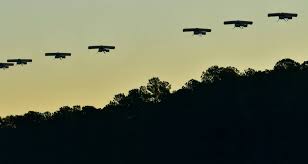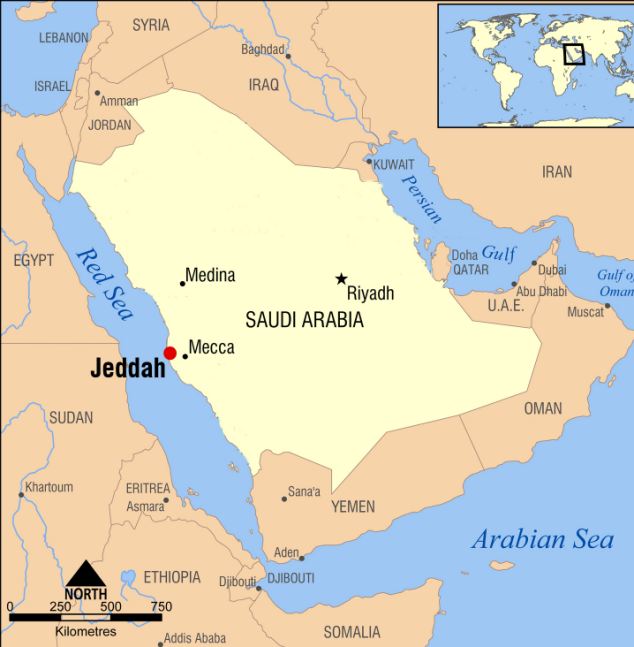Part 1 of 2 Parts
This is the age of the drone. From the size of insects to cargo hauling drones, these unmanned vehicles are exploding in variety and utility. Going beyond single drones, a lot of work is being poured into the creation of drone swarms which can work cooperatively. By definition, drone swarms are “multiple unmanned platforms and/or weapons deployed to accomplish a shared objective, with the platforms and/or weapons autonomously altering their behavior based on communication with one another.”
Today, I am going to focus on the use of drone swarms for military purposes. Drone swarms could be used for the delivery of different types of weapons including chemical, biological, radiological and/or nuclear. Such drones could travel in the air, on the land or in water to deliver deadly payloads. This blog will be about the use of drone swarms for nuclear offense and defense.
Drone swarms could serve as a new kind of nuclear missile defense system. They could even thwart hypersonic missiles currently being advertised as unstoppable. Swarms composed of thousands of cheap simple drones could be used to form defensive domes over high valued targets. Incoming missiles could be damaged or deflected by individual drones.
The same type of drone swarm could be used to form an aerial mine field, exploding on contact with nuclear bombers flying to targets. Even small drones could damage the wings and/or engines of aircraft. Low flying bombers hugging the terrain to avoid radar would be especially vulnerable to such air mines. In addition, short range drones could be used because they would need to cover less territory. Swarms of aerial, surface or submerged drones could be used to hunt for, follow, or even attack nuclear submarines.
Drones swarms could also be used for delivery of nuclear warheads. Research into such drone swarms is already being carried out by nuclear armed nations. They could also assist nuclear warhead delivery without needing to actually carry nuclear warheads themselves. Drone swarms could be used to confuse, disable or totally defeat the defense systems of enemies. Some missile defense systems are on mobile platforms and drone swarms are well suited to spread out and search broad areas for them. Drones could also masquerade as enemy aircraft to confuse and overwhelm air defense systems. Swarms of drones would be able to carry out coordinated maneuvers just like a fleet of aircraft to enhance the illusion.
It is possible that drone swarms could also assist in the targeting of nuclear warheads. Swarms of drones could be sent into enemy airspace to identify targets and gather information about defense system. Swarm principles could be applied to cruise missiles to allow them to coordinate to attack targets and avoid defenses. This would be particularly useful in what is known as counterforce strikes against military installation of an enemy. Such attacks require highly accurate and comprehensive identification of targets and precise strikes against such targets. Improving targeting is not as important for retaliatory strikes which deliberately target cities and civilians. More accurate targeting also means that less warheads and delivery systems are needed which reduces costs.
Please read Part 2
Blog
-

Nuclear Weapons 373 – Drone Swarms And Nuclear Warfare – Part 1 of 2 Parts
-

Geiger Readings for Feb 14, 2019
Ambient office = 100 nanosieverts per hour
Ambient outside = 130 nanosieverts per hour
Soil exposed to rain water = 130 nanosieverts per hour
Blueberry from Central Market = 122 nanosieverts per hour
Tap water = 110 nanosieverts per hour
Filter water = 99 nanosieverts per hour
-

Nuclear Reactors 656 – Why Saudi Arabia Should Not Get U.S. Help To Build Nuclear Power Reactors
Saudi Arabia in very interested in purchasing nuclear power reactors. They say that they want to use nuclear power internally so they can export more of their oil for export profits. Major suppliers of nuclear technology around the world are in discussion with Saudi Arabia about supplying those desired reactors.
The U.S. is no exception. U.S. nuclear companies want the Saudi contracts. There have been negotiations between the U.S. Energy and State Department and Saudi Arabia about making a deal involving U.S. companies. Unfortunately, there have been problems because the U.S. wants assurances that Saudi Arabia will not use U.S. nuclear technology to develop nuclear weapons and Saudi Arabia does not want to give those assurances.
Apparently, there were plans kept from public view for the U.S. and Russia to supply not just Saudi Arabia but other Middle Eastern countries with nuclear power plants Those secret plans were revealed during the investigation of Russian involvement in manipulating the 2016 U.S. Presidential election. Members of Trump’s inner circle had drawn up a comprehensive and complex plan to build and installed nuclear power reactors across the Middle East. The U.S. and Russia were supposed to supply the fuel for these plants and remove the spent nuclear fuel. Ultimately, the plan was abandoned. There has been speculation that Trump and/or others close to him may have had a financial interest in the plan.
It has been widely reported that Saudi Arabia is interested in obtaining nuclear weapons, especially if Iran is developing them. There are even reports that Pakistan actually has a standing order for nuclear warheads for Saudi Arabia if and when they want them delivered. Whether or not these reports and speculations are true, if Saudi Arabia obtains nuclear power reactors, other Middle Eastern Arab countries might take that as a sign that Saudi Arabia is working on nuclear weapons and a Middle Eastern nuclear arms race might be triggered.
Turkey is not an Arab country but it is a major player in the Middle East. Israel has nuclear weapons and is at odds with Turkey. If it looks like Saudi Arabia and Iran are developing nuclear weapons, it is a given that Turkey will want them too.
If a nuclear arms race starts up in the Middle East, it might not stay confined to that region. To the east, Pakistan and India are two nuclear powers in a tense standoff with each other. They have already fought several wars and the next one might involve nuclear weapons. Then there is China further east which has hundreds of nuclear weapons. If Saudi Arabia, Iran and Turkey acquire nuclear weapons, that would mean that there would be a corridor of nuclear armed nations from the Mediterranean Sea to the Pacific Ocean. Perhaps African nations and even South American nations might be caught up in a race to develop nuclear weapons.
Aside from the involvement of the U.S. government in building nuclear power reactors in Saudi Arabia, a number of U.S. corporations would be involved in the actual transfer to nuclear technology to the Middle East. Can these corporations be trusted to closely monitor the nuclear technology they supply to prevent any application of that technology to weapons development by Saudi
Arabia? Or would their greed overcome their better judgement and cause them to turn a blind eye to a Saudi nuclear weapons program?
It would probably be best for the world if Saudi Arabia did not obtain nuclear power reactors while the current regime holds power there. And, in any case, it would definitely be best for the U.S. not to be involved in building nuclear power reactors in Saudi Arabia. -

Geiger Readings for Feb 13, 2019
Ambient office = 128 nanosieverts per hour
Ambient outside = 135 nanosieverts per hour
Soil exposed to rain water = 137 nanosieverts per hour
Bartlett pear from Central Market = 89 nanosieverts per hour
Tap water = 59 nanosieverts per hour
Filter water = 54 nanosieverts per hour
-

Radioactive Waste 380 – NRC Says That Howard University Violate Rules Pertaining To Storage Of Radioactive Materials
Howard University was founded in 1867. It is a private research university composed of thirteen schools and colleges. It is located in northwest Washington, D.C. two miles from the U.S. capitol.
Last year, the university notified the U.S. Nuclear Regulatory Commission (NRC) that radioactive powder had been discovered in a small lidded jar in an unused physics lab. The jar was stored in a lead shielded container that was labeled as a storage unit for radioactive materials. The powder had been stored in the locked physics lab since at least 2014. A label on the jar said that the material had been received by the university in 1942.
The letter to the NRC said that the scientist who had last used the lab had retired in 2014. There is no information about how the powder came to Howard or whether the scientist made any use of it. The letter did not say that anyone had been exposed to the radioactive powder in the jar. The university did say that no one was harmed by the powder.
Investigators from the NRC found that the powder was actinium-227 which is a radioactive isotope. About eighty microcuries of actinium was found in the jar. A microcurie is one millionths of a curie which is a unit used to measure radioactivity. A letter from the NRC summarizing their findings said that the university was never authorized to be in possession of the radioactive material.
There was no evidence that the lab had suffered any contamination by the actinium. The NRC said that the university had failed to store the actinium in a ventilated hood or other containment device that would have prevented any from escaping into the air in the lab. The NRC said that if the actinium had been mishandled, someone could have received an unintended internal radiological dose.
The NRC decided that Howard had been responsible for a Severity Level III incident. The NRC categorizes radiological incidents into four different levels of severity with Level One being the most severe. Howard could have been fined up to seven thousand dollars for the violation. However, the NRC did not fine Howard because the university had taken “prompt and comprehensive” steps to deal with the problem.
Anthony Wutoh is the Howard Provost. He said, “Our priority remains the safety of our entire campus community. Once a potential risk was identified, the University adhered to all policies and best practices to assure the safety of our students, faculty and staff.”
The letter from the NRC was addressed to Wayne A.I. Frederick. It mentioned that the university had issued an order to the chairs of all academic departments to carry out an inventory of all radioactive materials in their labs to confirm that they do not have any unauthorized materials.
In 2008, there was an incident at Howard related to their handling of cesium-137, another radioactive isotope. In 2015, the NRC decided that Howard had violated safety rules with regard to the cesium incident in 2008. Last year, Idaho State University was fined eight thousand five hundred dollars for failing to properly maintain control and surveillance of one gram of plutonium. -

Geiger Readings for Feb 12, 2019
Ambient office = 128 nanosieverts per hour
Ambient outside = 135 nanosieverts per hour
Soil exposed to rain water = 137 nanosieverts per hour
Avocado from Central Market = 89 nanosieverts per hour
Tap water = 59 nanosieverts per hour
Filter water = 54 nanosieverts per hour
-

Radioactive Waste 379 – U.S. Department of Justice Sues Madison Support Alliance For Kickbacks At The Hanford Reservation
The Hanford Nuclear reservation in south central Washington State was used by the U.S. government to manufacture nuclear weapons from the Fifties through the Eighties. They left behind over a hundred tanks filled with toxic and radioactive materials that are leaking into the soil and scattered radioactive buildings. The Department of Energy is supposed to be cleaning up the mess, but they have been repeatedly sued by Washington State for endangering workers and failing to meet agreed upon schedules for phases of the cleanup plan. Now the DoE is suing a major contractor hired to carry out the cleanup.
The Madison Support Alliance (MSA) has a ten year three billion dollar contract signed in 2010 with the DoE to decontaminate the Hanford Reservation. Lockheed Martin Corporation (LMC) and Lockheed Martin Services Inc. (LMSI) were subcontractors hired to help at Hanford by MSA which is co-owned by another Lockheed Martin subsidiary.
MSA’s contract with the DoE was to provide management and technology services to the Department and other contractors involved in the massive cleanup project across the Hanford site. MSA says that it provides emergency response and training. It also provides environmental and land management, water and electrical utilities, cybersecurity and information management.
The U.S. Department of Justice claimed this week in court in the Eastern District of Washington that MSA abused its authority to hire subcontractors by awarding “improper favorable treatment” to some for kickbacks. The DoJ lawsuit alleges that LMC and LMSI executives received a million dollars from LMC and LMSI in violation of the Anti-Kickback Act to award a two hundred and thirty two million dollar contract for work at Hanford. LMC and LMSI then inflated the rates for the work they were subcontracted to do. In some cases, the two each billed MSA for the same work.
Jorge Francisco Armijo served as both the Vice President of LMC and the President of MSA. He was charge in the DoJ suit with abusing his authority for financial gain by holding posts in both companies at once. The DoJ suit said that Armijo “knowingly made or caused false statements to the DOE regarding the amount of profit included in the billing rates for LMSI under the subcontract it was awarded by its affiliate, MSA.” The DoJ also claims that the inflated rates violated the False Claims Act.
Jody Hunt is Assistant Attorney at the DoJ Civil Division. She said, “Where Congress has allocated money for specific purposes, we will not tolerate unlawful conduct by contractors who seek to enhance their profits at the expense of taxpayers.”
Joseph Harrington is the U.S. Attorney for the Eastern District of Washington. He said, “The critical mission of cleaning up the Hanford Site in a safe, timely, environmentally responsible, and cost-effective manner is too important to the public and the residents of this region. …fraudsters (will be held) accountable, whether they are individuals, businesses, or the nation’s largest corporations.”
Lockheed immediately denied the allegations. They rejected any notion that the “corporation or its executives engaged in any wrongdoing.” MSA also denied the charges and went on to say that “We look forward to presenting a strong defense in this matter, and as always, we stand behind our team of incredible employees to perform extraordinary work supporting the Hanford mission. Ethical business conduct is a hallmark of MSA and we are committed to integrity and compliance throughout all levels of the company.”
